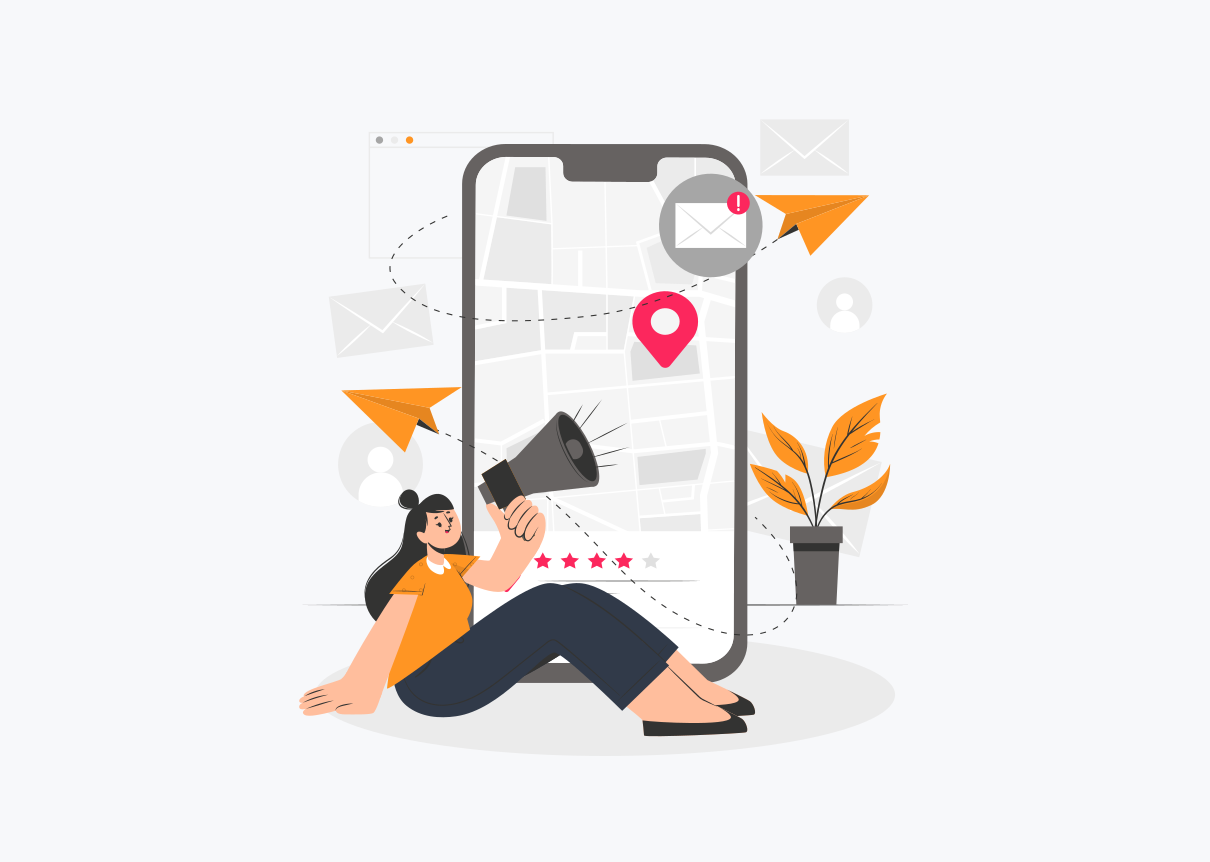Ultimate Local Marketing Guide: How To Reach High-Paying Customers In Your Local Area
Whether you’ve been in business for years or you’re the new kid on the block, a solid local marketing plan can be the difference when competing for customers in your neighborhood.
Starting a local business doesn’t automatically equal sales.
Gone are the days when towns had one or two options for specialized services, or a single plumber on speed dial. Local trade businesses are seeing more competition as demand grows, and the market grows with it.
With more options, consumers become more conscious of who they choose and why.
With the influx of competing businesses, it’s more important than ever to find ways to create connections with potential customers and build trust.
While you might picture going door to door or standing outside your local supermarket handing out flyers, local marketing strategy typically plays out online. This digital approach is even more critical with the changes brought on by the recent pandemic.
Everyone looks for everything online.
In fact, 51% of consumers find new companies via search. So without an online marketing plan, you’re invisible.
We’re going to cover everything you need to know to put local marketing resources and methods to work for your business, and start stealing local customers from the competition in the process.
What is local marketing?
Local marketing is the collection of strategies you can use to create awareness about your company and connect with new and existing customers within a set radius – all online.
For example, if you want to connect with a customer who lives within 10 miles of your business, or inside your local service area, you’ll need local marketing to make the connection.
This can occur on:
To ensure you’re found by local customers, you’ll need to combine a range of approaches that create a solid footprint for your company on the web.
What does local marketing look like?
It’s easy to hear ‘local marketing’ and assume it involves a lot of face-to-face time and pounding the pavement in your community, but local marketing is best applied online.
Even if your target customer is just down the street, you have to meet them where they spend their time searching for products and services – and that’s the internet.
Mind you, there’s no harm in integrating some real-world methods. There’s still merit in wrapping your truck or leaving signage on the front lawn of a job well done (people do slow down and jot those numbers into their phone from time to time).
But the vast majority are more likely to take note of your business and then start Googling to see what you offer (and what people say about you).
With 81% of people doing their own online research before making a purchase decision, that’s a lot to miss out on if you’re nowhere to be found.
Are customers looking for local businesses?
Yep, in huge numbers.
Four out of five people are searching for local information online. The key here is to be in front of the right people in the right place with the right content.
Local marketing is about a laser-focused approach to reach.
You don’t want as many people as humanly possible to see your name up in lights because the spend is typically higher and the return can be underwhelming if you’re putting your business in front of customers who live 500 miles away.
In contrast, local marketing is focused and tactical.
You’re looking to get your brand in front of specific people, usually in a specific area looking for specific services (did we mention ‘specific’ enough yet?). Fewer people may see your business if you aren’t advertising on all seven continents, but the people who do see your business listing or ad are much more likely to make a purchase.
What is the goal of local marketing?
You’re a local business and you offer a range of contractor services. But word of mouth isn’t going to supercharge your revenue and send you retiring to the beach – you need new business to grow your business.
Local marketing offers a range of benefits that you’ll want to start tapping into ASAP.
Local marketing generates exposure
Local marketing helps customers find you.
Unless a potential customer specifically knows your company name, no one is searching for “Bob’s Contracting Company”. They’re searching “home remodeling help near me” and Google is serving up what they think is the best fit.
Local marketing improves your reach
Someone found you listed online, great job!
But can they contact you in the real world? If you aren’t managing your local marketing (or don’t have a website at all), customers will struggle to find the right contact info for you.
If local business details are wrong online, 80% of consumers will move on to the next choice and lose trust in your company.
Local marketing boosts your credibility
Even the 85% of businesses benefiting from word of mouth and referrals still need an online presence.
Most people are likely to conduct a search to verify your information and see what the wider public have to say about you. With 55% of customer research focused on reviews, what you are known for certainly matters.
How to make a good first impression with local marketing
All of the flyers, business cards, and coupons in the world won’t help if you’re invisible online.
Just like a job interview or blind date, you want to put your best foot forward when meeting someone for the first time. And that’s exactly what local marketing is for.
Your website, business listing, or Facebook page could all be a potential customer’s initial glimpse of your company, so here’s what questions you need to answer across your local touchpoints.
“Is this company any good?”
This is what people are asking themselves as they check out your online reputation. You can help mould the answer by chasing up reviews, which are the core source of this information, affecting 67.7% of all purchasing decisions.
While one post with negative feedback from a grumpy customer won’t ruin business, several posts with zero response from you are much more likely to do damage, so be sure to reply to all reviews to show you’re an engaged business owner.
“Why doesn’t this load on my iPhone?”
Ok, maybe they won’t say iPhone, but people will judge your local marketing based on its ability to load on their smartphone.
If you have a website for your business, you have to make sure it is responsive, which is a fancy term for whether you can view the website just as easily on a smartphone as you can on a giant computer monitor.
No one is going to grapple with a clunky site that doesn’t load on their phone, with 48% of users reporting they would move on to a competitor if a site isn’t mobile-friendly.
Looking to create a fast and mobile-friendly site? Use the Pedestal website builder for FREE now.
“Will this business help me…?”
When people search, they’re looking for answers.
If you create content (blogs, helpful social posts) that answers some common questions in your field, you can show off your expertise and build your credibility.
While many people search in the form of a question (i.e. How do I repair drywall?), content including specific keywords (i.e. repair drywall) shows up in the results. If you have tips on how to DIY repair drywall, your post can bring in plenty of eyeballs – many of which may contact you instead of tackling their home improvement project themselves.

Local marketing tactics: Your practical plan to divide and conquer
Local marketing is as diverse as it is flexible.
You have plenty of options open to you depending on your business and goals. And the good news is you don’t have to take them all on at once.
We’ve compiled a variety of local business marketing options for your consideration. Each offers a different approach and advantage and with 46% of Google queries focused on local information, it’s never too late to get started.
Local SEO
No local marketing strategy is complete without addressing the search elephant in the room – Google.
You need to optimize your online presence to help you appear for local searches – which are triggered when people use the keyword ‘near me’ or their location. For example:
- ‘service + near me’
- ‘service + location’
- ‘best service in location’
Having a website is the foundation of local marketing. This is how you can rank for local keywords, and connect with people in your zip code. Just make sure your content and keywords have local intent, so mention your suburb, any major landmarks, streets, etc.
Google My Business (GMB)
One great – and fairly easy – way to boost your search rank is to build out your Google My Business (GMB) listing.
These listings work like directories for companies with contact information, details, and even pictures. The more accurate and complete your listing is, the more helpful it will be to attract customers.
Google prioritizes these listings in its own search results when it thinks they’re super relevant to what a person is searching. (If you don’t have a listing, check out our Guide to Google My Business Listings for Local Businesses to get yours up and running for FREE.)
Local citations
While Google dominates the listing game, it’s not the only player in the space.
You can list your business on any number of citation websites, which work like local directories. As long as your information is consistent across the board (to avoid confusing customers), you can build up your web footprint nicely.
Common citation sites include:
- Yellow Pages
- Yelp
- Foursquare
- Bing Places
- Hot Frog
Oh, and if you’re after more business listing sites, check out the EIGHTY we’ve put together for you here
Be sure to include pictures and interact with anyone leaving reviews (positive or otherwise) to increase engagement with your community.
Write blog posts
Every business has stories to tell, especially as experts in their field.
Whether you add a blog to your website or use the Posts sections on Google My Business or Facebook, adding content can show off your knowledge.
Keep in mind that Google likes to see regular, relevant content about topics when it looks to decide if it should recommend pages in search. Adding blog content about your services, recent projects, business background, and even how-to guides can help increase your exposure and show off your stuff.
Think Facebook (and social media in general) is a waste of time?
It might be if all you do is watch cat videos.
But the truth of the matter is that Facebook and its network have over 3 billion users, and 600 million of them check out Facebook business pages.
Create your profile and keep an open mind about other social media options, too. Twitter, LinkedIn, and even Instagram can be excellent platforms for connecting with people and showcasing your work. The key here is to stay engaged – create posts, answer questions, and post regularly.
Run paid ads
You can also pay for exposure to different local audiences.
With your website in place, you can purchase ad space that calls out your services and directs people back to your site or contact information. Here are a few paid ad options for you to consider:
Google Ads
All roads lead back to Google, and they’ve mastered local ad targeting.
You can run Google ads based on a specific local area where you provide services. The best part? You only pay for an ad if you receive a click, so there’s less wasted spend. Oh, and businesses who run Google Ads see an average of $2 revenue for every $1 spent, which isn’t too bad either.
Facebook ads
We’re back to Facebook again.
But as the 4th largest search engine, it deserves a bit more attention. Just like on Google, you can place ads on the Facebook platform and target users based on location. You can narrow down your campaign based on specific towns or an exact radius.
Remarketing
Sometimes people visit a website as a casual browser, not ready to make a decision. What if you were able to target those people with follow-up ads to keep your business top of mind? Remarketing does just that.
Services like Google let you present ads to people as they continue to move through the internet. This keeps your brand on their mind and gives them an easy route back to you when they’re ready to move forward.
Join local groups, forums and communities
Social media lets people connect with people they know. It also helps them make new connections based on common interests.
Facebook Groups are one way people come together, and you can use this in your local marketing strategy. Join local community groups for your town or county. You can carry on the conversation and even share a bit about your business when the time is right.
Other web platforms encourage these discussions too.
You can search sites like Reddit for threads based on specific topics (i.e. Home Repair or DIY Projects) and chime in with helpful advice. Following hashtags on Twitter can also create a similar effect where you can reply to people or use the same hashtags to add to the conversation (and include links back to your website).
Create a program to foster loyalty
Everyone likes discounts, rewards, and free stuff.
Consider creating a loyalty program that encourages people to share their experience with your business or recommend customers to you.
You can offer coupons for a future service and extend discounts for every referral that turns into a sale. Get creative with your customers, and they’ll be more likely to spread the word about your business on a local level.
Offer free local consultations
Home improvement projects can be downright overwhelming for a homeowner. This prolongs their decision-making process and increases the chances they’ll consider more service providers for the job – which pits you against more competition than you’d like.
One way you can get ahead of the competition is to offer free consultations.
This encourages customers to engage with you while they are exploring options. For big projects like renovations, remodeling, or overhauling a space (inside or outside), you can show off expertise and empathy to the customer all while helping them move along in the process.
Connect with local media outlets
Newspapers, radio, TV, blogs, journalists.
Don’t leave out more traditional media outlets as part of a total local marketing plan.
For example, reach out to community newspapers, bloggers, and journalists with a unique story. Share how important your town or county is to you, how you have made an impact, any volunteerism or plans to give back.
You’ll get some mixed media exposure with people who still read the Sunday morning paper or turn on Channel 2 while cooking dinner. You’ll also benefit from how these channels repurpose the content online, with more pages and stories hitting the internet with your company name, keywords, and links.
Get involved with local events (or sponsor them)
You can also spread the word at a local level by hosting or sponsoring events. Sometimes all it takes is to get your logo out in front of the masses.
Check with your town or community event boards for upcoming programs. The YMCA, local Scout troops, schools, and sports teams are always looking for a bit of financial support and are happy to include sponsor details on their flyers, signage, and banners.
Cross-sell your services to local customers
Don’t forget the value of your prior customer base.
A job well done does not mean a door is closed. It’s been shown that acquiring a new customer can cost 5x more than retaining an existing customer, so ensure your previous customers still feel the love.
Create reminders to check in with past customers and ask how things are going. Send information about related services you offer for them to keep in mind. You can include details about your loyalty program or other discounts (see above) or share new offerings that were not available the last time you spoke.
Personalize your local marketing with omnichannel campaigns
Customers expect a consistent, personalized experience with the brands they work with.
You can apply this tactic – known as omnichannel marketing – by delivering content that caters toward specific user interests across different platforms. The goal is to keep the branding and awareness going as people move around the internet.
Here’s an example to break it down:
- A user fills out a form on your website and they’re sent an automated email. (Web)
- Two days later, you send them a text to follow up on their project. (SMS/Phone)
- Since you’re running remarketing ads, they see your brand the next day on another website (Ad)
- By the end of the week, they get a postcard with a discount for their first service (Direct Mail)
- They search your business and see your listing on Yelp (Citation)
- When they go to Facebook, they see a sponsored post with a link to your site (Ad)
Multiple channels, one shared message.
BONUS: Go the extra mile with local geotargeting
If you really want to hone in on your local market, geotargeting could be the answer.
We already touched on the fact that some advertising platforms let you set a town or a radius to show your ads to. But what if you want a very specific location, or a subset of a subset in your community?
Geotargeting takes this all a step further.
You can advertise to:
|
|
This is especially effective for mobile users since their physical location changes as they’re moving about.
This can even let you show promotions to people based on their proximity to a specific location. Local targeting creates higher success rates since you’re getting in front of the right people at the right time: 78% of mobile search that targets based on location results in offline purchase. It pays to be precise.
Google (both Search and Maps) and Facebook are two great examples that let you target based on specific user location data. You can also use Google Trends to find what terms are popular in which locations near you for maximum effect.
“Near me” searches are your best friend
People are savvy to the fact that Google, and the internet at large, knows quite a bit about them.
And that trickles right down to location. Instead of searching “drywall repair in Boise, Idaho,” web users can simply enter “drywall repair near me” and get the results they need.
Here’s the most important takeaway of this entire article – Near Me search has increased 200% in the past two years.
To stay relevant and rank for “near me” searches you need to ensure your location and NAP details are consistent everywhere your business is listed. Supercharge your local marketing by including local keywords (plus the services and products you want people to find you for) in all of your content.
Remember, you want to rank for the service (i.e. drywall repair) and not “near me” itself.
Turn your neighbor into a customer with local marketing
There’s nothing stopping you from waving hello to the guy next door and asking if he needs a contractor or knows someone who does.
But as word of mouth has moved online, you need to do the same.
The majority of consumers take to the internet to search and research services, so you need a strong local marketing strategy to stay visible and competitive.
With a variety of tactics available, it might take a bit of trial and error to find the right mix for your marketing, but try rolling out one or two at a time so you can determine what’s working and what’s not.
You’ll want to consistently measure your results to make data-driven decisions on what works best for your business.
No doubt, local marketing offers many advantages when it comes to reaching new audiences. People who have never heard of your business will find you because they need your service. And by improving your search rankings and exposure to online consumers, you’ll further establish your business as the #1 choice in the local area.
We believe in you – you can totally do this! But if you want some support along the way, the team at Tradie Digital is standing by.







